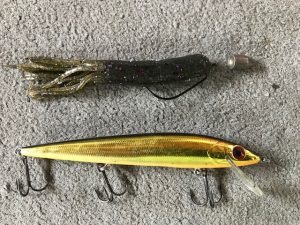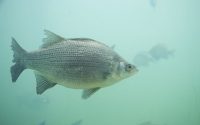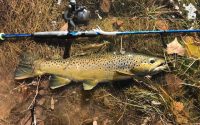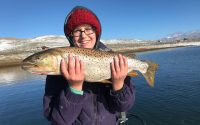Fall Shore Angling – Three Important Tips

This week, let’s take a look fishing from the shore and, hopefully, entice you to get out of that easy chair, turn off the football game, and catch some “stout” trout while enjoying this hot and cold (weather wise) extended fall fishing season.
I watched a few shore anglers last week trying to mirror those in boats by literally following them in and out of coves. Frustrated, they watched as those in the boats caught fish and they (on the shore) did not. The shore anglers were unable to get deep enough to access the “gut” or center of the cuts or coves where the fish were holding.
It was obvious they were confused, not knowing what the fish wanted and how to present it to them. In one case, an angler called out to me and asked what we were using and how they too could begin to catch fish. I tried to explain but there was really no way he could fish the techniques we used, based on this tackle.
Differences Between Shore and Boat Fishing
When fishing from the shore, (especially in the fall) you must find steeper banks, or points that gradually but quickly move from the shore to 20 feet deep. For example, on Deer Creek, the shoreline on the southeast side of Rainbow Bay moves from a shallow flat near the parking lot to a very deep point towards the main lake. Although anglers catch fish on the shallow flat at times throughout the year, the better choice (now) would be to fish the outer third of the shoreline where the water gets deep in a hurry.
Also, the choice of fishing line is crucial to finding success from the shore. I use a Berkley line called NanoFil. It is a Uni-Filament line that resembles braid and casts better than any spinning line I’ve used. When fishing the mouths of bays, I can stand on the shore, cast, and sometimes reach the “gut” or center of the mouth quite easily.
It is also important to use the correct lures that go hand-in-hand with your shore angling techniques. Try fishing “Texas-rigged” tube jigs, and instead of suspending jerkbaits, floating jerkbaits.
The key is to get the lures in the heart of the strike zones and at the same time be able to get them back to the shore without getting caught on brush and grass or covered with sticky moss.
Using a Texas-rigged Tube
The photo accompanying this column shows a Texas-rigged tube and a floating jerkbait. The floating jerkbait will dive as you reel but when you pause, will return to the surface. By keeping the rod tip high, you should be able to easily bring your jerkbait through brush, grass and moss.
To rig a Texas-rigged tube, use a 2/0 or 3/0 extra wide gap hook and a 1/8- or 1/4-ounce bullet weight. Slide the bullet weight on the line, tie the hook to the line using a Palomar knot, and thread the tube on the hook by piercing the center of the top of the tube with the point of the hook, and pushing the point out of the side of the tube about 1/2 inch below the point you pierced. Then, turn the hook around and pull the hook down, carefully directing the eye of the hook so that it barely protrudes from the top of the tube, and the entire hook except the eye and a tiny portion of the shank are outside the tube. Then, bury the point of the hook into the side of the tube towards the bottom and leave the point inside the tube.
If you choose to push the tip of the hook out the opposite side of the tube, you can still put a piece of night crawler on the hook. This technique will allow you to reel in the tube with fewer snags.
Finding deeper points, and casting the right line to the center of bays and cuts, using tubes and floating jerkbaits are without a doubt three great ways to target trout from the shore.










